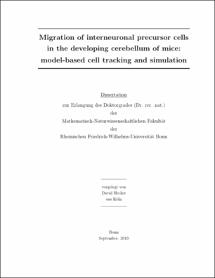Migration of interneuronal precursor cells in the developing cerebellum of micemodel-based cell tracking and simulation

Migration of interneuronal precursor cells in the developing cerebellum of mice
model-based cell tracking and simulation

| dc.contributor.advisor | Alt, Wolfgang | |
| dc.contributor.author | Hecker, David | |
| dc.date.accessioned | 2020-04-15T21:04:46Z | |
| dc.date.available | 2020-04-15T21:04:46Z | |
| dc.date.issued | 10.12.2010 | |
| dc.identifier.uri | https://hdl.handle.net/20.500.11811/4695 | |
| dc.description.abstract | The navigation of precursor cells of inhibitory interneurons from their germinal zone inside the fourth ventricle through the white matter towards their final destination within the cerebellum's molecular layer is an ongoing research topic. On the basis of time-lapse images of cerebellar slices of P8 mice we performed automated model-based cell tracking employing image forces derived from pixel brightness values. We found that cells show dierent modes of migration in cerebellar grey and white matter. Furthermore, we found indication that these cells migrate along guiding structures. We then developed a model of this type of cell using an approach of structure in uenced protrusive activity. We showed that the model is capable of generating cell paths very similar to tracked real cell paths of interneuronal precursor cells and, furthermore, were able to depict both observed modes of migration. Our model predicts that the change in migration behaviour originates solely from a change in guiding structures and not from internal changes of the cells. The two main attributes of a guiding structure, namely attraction of the cells in question and imparting guidance information, are the underlying cause of changes in migration behaviour. | en |
| dc.description.abstract | Die Wanderung von Vorläuferzellen inhibitorischer Interneurone von ihrer Keimzone am vierten Ventrikel, durch die weiße Substanz, bis hin zu ihrem endgültigen Zielort in der Molekularschicht des Cerebellums, ist ein aktuelles und aktives Forschungsgebiet. Wir haben eine Methode zur automatisierten Zellverfolgung (Tracking) auf der Basis von Bildkräften, hergeleitet aus Pixelhelligkeiten, entwickelt. Mit Hilfe dieser Methode haben wir die Bewegung von Zellen in time-lapse Aufnahmen von Gewebeschnitten des Kleinhirns von P8 Mäusen verfolgt und ausgewertet. Die Ergebnisse zeigten unterschiedliche Eigenschaften der Migration dieser Zellen innerhalb der weißen und grauen Substanz. Außerdem erhielten wir Anzeichen für die Existenz von Leitstrukturen. Wir haben dann ein Modell dieses Zelltyps entwickelt, das auf Struktur-beeinflusster protrusiver Aktivität beruht. Wir haben gezeigt, dass dieses Modell in der Lage ist Zellpfade zu generieren die den Tracks echter Zellen vergleichbar sind und zusätzlich fähig ist die beobachteten Änderungen im Migrationsverhalten in den beiden Bereichen (graue und weiße Substanz) nach zu bilden. Unser Modell sagt vorher, dass der Übergang beider Migrationsmodi hauptsächlich von Umgebungsstrukturen und den Eigenschaften des Gewebes herrührt. Die beiden Haupteigenschaften der Leitstrukturen in Bezug auf Migration, Attraktion und Guidance, bilden die Grundlage für diese Veränderungen. | en |
| dc.language.iso | eng | |
| dc.rights | In Copyright | |
| dc.rights.uri | http://rightsstatements.org/vocab/InC/1.0/ | |
| dc.subject | Kleinhirn | |
| dc.subject | Interneuronen | |
| dc.subject | Entwicklung | |
| dc.subject | Migration | |
| dc.subject | mathematische Modellierung | |
| dc.subject | time-lapse | |
| dc.subject | Cerebellum | |
| dc.subject | Development | |
| dc.subject | Interneuron | |
| dc.subject | mathematical modelling | |
| dc.subject.ddc | 004 Informatik | |
| dc.subject.ddc | 500 Naturwissenschaften | |
| dc.subject.ddc | 510 Mathematik | |
| dc.subject.ddc | 570 Biowissenschaften, Biologie | |
| dc.subject.ddc | 610 Medizin, Gesundheit | |
| dc.title | Migration of interneuronal precursor cells in the developing cerebellum of mice | |
| dc.title.alternative | model-based cell tracking and simulation | |
| dc.type | Dissertation oder Habilitation | |
| dc.publisher.name | Universitäts- und Landesbibliothek Bonn | |
| dc.publisher.location | Bonn | |
| dc.rights.accessRights | openAccess | |
| dc.identifier.urn | https://nbn-resolving.org/urn:nbn:de:hbz:5N-23705 | |
| ulbbn.pubtype | Erstveröffentlichung | |
| ulbbnediss.affiliation.name | Rheinische Friedrich-Wilhelms-Universität Bonn | |
| ulbbnediss.affiliation.location | Bonn | |
| ulbbnediss.thesis.level | Dissertation | |
| ulbbnediss.dissID | 2370 | |
| ulbbnediss.date.accepted | 19.11.2010 | |
| ulbbnediss.fakultaet | Mathematisch-Naturwissenschaftliche Fakultät | |
| dc.contributor.coReferee | Schilling, Karl |
Files in this item
This item appears in the following Collection(s)
-
E-Dissertationen (4442)




